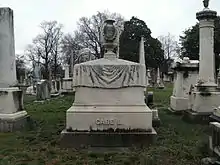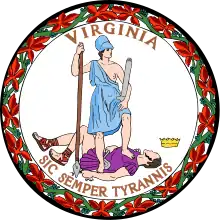William H. Cabell
William H. Cabell (December 16, 1772 – January 12, 1853) was a Virginia lawyer, politician and judge aligned with the Democratic-Republican party. He served as Member of the Assembly, as Governor of Virginia, and as judge on what later became the Virginia Supreme Court. Cabell adopted his middle initial, which did not stand for anything, in 1795, to distinguish himself from other William Cabells, including his uncle, William Cabell Sr.[1][2]
William H. Cabell | |
|---|---|
.jpg.webp) Portrait of William H. Cabell by Flavius Josephus Fisher | |
| 14th Governor of Virginia | |
| In office December 7, 1805 – December 1, 1808 | |
| Preceded by | John Page |
| Succeeded by | John Tyler, Sr. |
| 6th Chief Justice of Virginia | |
| In office January 18, 1842 – December 31, 1850 | |
| Preceded by | Henry St. George Tucker, Sr. |
| Succeeded by | John J. Allen |
| Justice of the Virginia Supreme Court | |
| In office March 21, 1811 – December 31, 1850 | |
| Member of the Virginia House of Delegates representing Amherst County | |
| In office November 8, 1796 – December 3, 1797 Serving with Joseph Burrus | |
| Preceded by | William Cabell Jr. |
| Succeeded by | Joseph Shelton |
| In office December 3, 1798 – November 30, 1799 Serving with William Ware | |
| Preceded by | Joseph Shelton |
| Succeeded by | David S. Garland |
| In office December 6, 1802 – January 1, 1805 Serving with John Camm, Hudson M. Garland | |
| Preceded by | David S. Garland |
| Succeeded by | Charles Taliaferro |
| Personal details | |
| Born | December 16, 1772 Cumberland County, Colony of Virginia, British America |
| Died | January 12, 1853 (aged 80) Richmond, Virginia, U.S. |
| Political party | Democratic-Republican |
| Spouse(s) | Elizabeth Cabell, Agnes S. B. Cabell |
| Alma mater | Hampden-Sydney College College of William and Mary |
| Profession | Lawyer, judge |
Early life
Cabell was born at "Boston Hill", in Cumberland County in the Colony of Virginia on December 16, 1772. The eldest of the three surviving sons of Colonel (and burgess) Nicholas Cabell (1750-1803)[3] and Hannah Carrington Cabel (1751-1817)l, both of the First Families of Virginia. His younger brothers were Joseph Carrington Cabell (who helped found the University of Virginia and served in both houses of the Virginia General Assembly)[4] and Nicholas Cabell. The family also included daughter Mary Ann Cabell Carrington (1783-1850).
Young William Cabell studied with private tutors and, later attended and graduated from Hampden–Sydney College in 1789.[5] He then moved to Williamsburg and attended the College of William and Mary, where he took legal courses from Judge St. George Tucker before graduating in July 1793. Young Cabell then moved to Richmond to read law.
Career
Cabell began his legal career soon after his admission to the Virginia bar on June 13, 1794, and also followed his father's footsteps in entering politics. Amherst County voters elected him to the Virginia House of Delegates to succeed his cousin (after adopting his distinguishing initial). Although Amherst County voters failed to re-elect him after that term, this Cabell would serve multiple terms as one of Amherst County's two (part-time) delegates before being elected the 14th Governor of Virginia and serving from 1805 to 1808.[6]
In one of his early legislative terms, Cabell voted for the Virginia resolutions against the alien and sedition laws, which were designed to impede his political party. Cabell also served as Republican Presidential elector in 1800 and 1804. While he was Virginia's governor, the British sloop of war Leopard attacked the frigate Chesapeake off Norfolk (the Chesapeake–Leopard affair later known as a forerunner of the War of 1812) and former Virginia governor Thomas Jefferson ordered the arrest of Vice President Aaron Burr for the Burr conspiracy. Burr went on trial for treason in Richmond, because much the planning took place in lands Virginia once claimed in the Ohio Valley, but was acquitted as U.S. Supreme Court Chief Justice John Marshall (a fellow Richmond resident) found insufficient evidence of treason, although much conspiracy.
Judicial career
As his gubernatorial term ended, in December 1808, the General Assembly elected Cabell a judge of the general court. Two years later, legislators selected him for a vacant seat on the Supreme Court of Appeals. He began serving on that court on March 21, 1811, and served continuously for more than four decades. During the court's reorganization in 1831, Cabell was again selected to the new court, where he became president on January 18, 1842. He remained in this position until 1850, but during the last year before his resignation had several absences due to ill health.
Personal life

Cabell built the Midway Mill in 1787, which later was listed on the National Register of Historic Places, but demolished in 1998.[7][8] In 1795, back in Amherst County, William Cabell married Elizabeth Cabell (1774-1801), but they had no children who survived. After her death, on March 11, 1805, he married Agnes Sarah Bell Gamble, eldest daughter of Colonel Robert Gamble, of Richmond.[9] Their children included:
- Emma Catherine Cabell Carrington (1808–1887)
- Robert Gamble Cabell (1809–1889)
- Elizabeth Hannah Cabell Daniel (1811–1892)
- William Wirt Cabell (1813–1891)
- Edward Carrington Cabell (1816–1896), who moved to Florida and served in its legislature, as well as the U.S. Congress.
- John Grattan Cabell (1817–1896)
- Henry Coalter Cabell (1820–1889).
In 1840, Judge Cabell's household consisted of seven free white persons and ten slaves (2 adult men, 4 boys under age 10, 4 adult women).[10] In 1850, he and Agnes lived with lawyer sons William Cabell (aged 35) and Henry Cabell (age 30 and his wife) and an unspecified number of slaves.[11][12]
Cabell died on January 12, 1853 in Richmond, Virginia and was interred in Shockoe Hill Cemetery.
Legacy
Cabell's executive papers are held at the Library of Virginia.[13]
Cabell County, West Virginia was named in his honor, as is a residence hall at William & Mary.[14]
References
- Brown, A. The Cabells and their kin: a memorial volume of history, biography, and genealogy. Richmond, Va.: Garrett and Massie, 1939, p. 251.
- "The Cabell Family Papers – Albert and Shirley Small Special Collections Library". Retrieved July 1, 2016.
- "The Cabell Family Papers – Albert and Shirley Small Special Collections Library". Retrieved July 1, 2016.
- https://www.encyclopediavirginia.org/Cabell_Joseph_C_1778-1856. Missing or empty
|title=(help) - "Lacy, Drury". The National Cyclopædia of American Biography. II. New York: James T. White & Company. 1921. p. 22.
- Cynthia Miller Leonard, The General Assembly of Virginia: 1619-1978 (Richmond: Virginia State Library 1978) pp. 203, 211, 227, 231, 235, 239 518.
- Virginia Historic Landmark Commission staff (January 1973). "National Register of Historic Places Inventory/Nomination: Midway Mill" (PDF). Virginia Department of Historic Resources.
- "National Register Information System". National Register of Historic Places. National Park Service. July 9, 2010.
- Encyclopedia of Virginia Biography (1915) unpaginated but available online at ancestry.com
- 1840 U.S. Federal census for Richmond, Virginia.
- Neither Virginia probate nor slave census records are available online and the recording of slaves differed in the 1840, 1850 and 1860 federal censuses.
- 1850 U.S. Federal Census for Richmond, Virginia,
- A Guide to the Governor William H. Cabell Executive Papers, 1805–1808
- "William & Mary – Cabell & Nicholas Halls". Wm.edu. Retrieved July 2, 2016.
Further reading
- Brown, A. The Cabells and their kin: a memorial volume of history, biography, and genealogy. Richmond, Va.: Garrett and Massie, 1939, pp. 240-255.
| Political offices | ||
|---|---|---|
| Preceded by John Page |
Governor of Virginia 1805–1808 |
Succeeded by John Tyler, Sr. |
